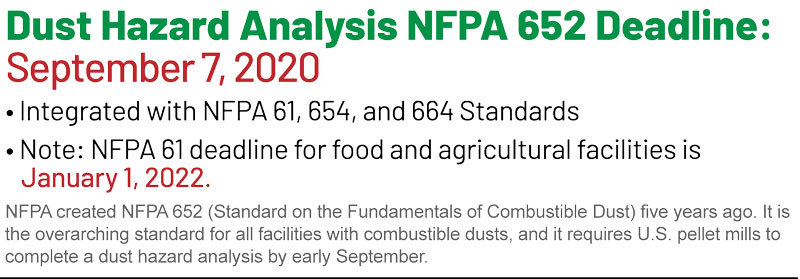Changes to Dust Fire and Explosion Standards







May 26, 2020
BY Jeff Davis
Numerous standards exist to prevent dust fires and explosions. In the United States, the National Fire Protection Association is charged with creating and maintaining standards for fire prevention, including standards associated with combustible dust. Many of these standards have seen updates or revisions recently, with the biggest changes focused on the requirements for conducting a dust hazard analysis (DHA). In fact, significant proposed changes are currently in the works.
NFPA maintains over 300 codes and standards covering all aspects of electrical, fire and explosion safety. While NFPA has no enforcement power of its own, authorities having jurisdiction (AHJs) often reference NFPA standards in their own regulations. AHJs include the Occupational Safety and Health Administration (OSHA), as well as local fire marshals and building permitting and inspection offices. In the United States, maintaining compliance with NFPA’s combustible dust standards generally falls on the individual facility rather than on equipment manufacturers. Facilities must determine if they have combustible dusts, what standards they would fall under, and what requirements they must comply with based on the equipment they operate in their operation. This differs from, for example, the European ATEX standards which require detailed certification processes on the equipment vendors for all equipment utilized for combustible dust.
The NFPA standards for combustible dust that pertains most directly to pellet and biomass industries are as follows:
• NFPA 652: Standard on the Fundamentals of Combustible Dust, 2019 Edition
Advertisement
Advertisement
• NFPA 664: Standard for the Prevention of Fires and Explosions in Wood Processing and
Woodworking Facilities, 2020 Edition
• NFPA 61: Standard for the Prevention of Fires and Dust Explosions in Agricultural and Food Processing Facilities, 2020 Edition
• NFPA 654: Standard for the Prevention of Fire and Dust Explosions from the Manufacturing, Processing, and Handling of Combustible Particulate Solids, 2020 Edition
• NFPA 68: Standard on Explosion Protection by Deflagration Venting, 2018 Edition
• NFPA 69: Standard on Explosion Prevention Systems, 2019 Edition
NFPA 61, 654, and 664 are called the commodity-specific standards. The purpose of these standards is to give specific industry types combustible dust standards based on their type of operation. A wood pellet facility would utilize NFPA 664, while an agriculturally based pellet mill (e.g. peanut shells) would utilize NFPA 61. NFPA 654 exists for general manufacturing facilities that do not have their own specific commodity standard.
Advertisement
Advertisement
With so many standards that could be used, it is easy to get confused on which to follow, especially as recommendations can vary across the standards. For this reason, NFPA created NFPA 652: Standard on the Fundamentals of Combustible Dust in 2015. The purpose of NFPA 652 was to serve as the overarching standard that applies to all facilities with combustible dusts, and be the starting point for each facility. NFPA 652 was the first standard to issue the requirement for conducting a DHA. In the current 2019 edition of NFPA 652, the deadline for completion of the DHA is September 7, 2020. The current editions of NFPA 61, 654, and 664 have all worked to integrate NFPA 652 into their standard.
The goal from each of the commodity standards was to reduce the reliance on two different standards: NFPA 652 and their standard. However, this still can lead to confusion. The 2020 edition of NFPA 654 restated NFPA 652’s DHA completion deadline of September 7, 2020. NFPA 664 does not state the deadline, but instead refers directly to NFPA 652. The 2020 edition of NFPA 61 states that the deadline for food and agricultural facilities is January 1, 2022. NFPA’s guidelines state that when there are differences between 652 and the specific commodity standard, the user can choose either standard.
The commodity-specific standards have always contained numerous “prescriptive requirements.” These are the specific sets of requirements for types of equipment. For example, each of the standards have requirements for dust collectors that include explosion protection and other monitors, alarms, etc. There has also been the option for “performance-based design options” which, historically, utilized a process hazard analysis (PHA) type approach. The 2020 editions of these standards are no different in that both prescriptive and performance-based options are still incorporated. However, what we see in all these standards are further explanations and guidance leading toward conducting the DHA, and using those results to determine where the prescriptive requirements should be incorporated. For example, if utilizing only the prescriptive requirements (or the checklist DHA examples provided in some of the standards), you would install explosion protection on all your specific equipment with a prescriptive requirement. But, if you were to conduct a detailed DHA that examined the potential for hazardous atmospheres and hazardous ignition sources, you may find that some equipment at your facility does not have the potential for a hazardous atmosphere, or there are no potential ignition sources. If that is the case, you may not need to implement the prescriptive requirements for that piece of equipment. While these performance-based design options have always been acceptable, current versions of the standards have made their viability clearer than before.
In summary, the major NFPA requirement affecting the pellet and biomass industry is the need to conduct a DHA, with a deadline that is fast approaching. Facilities utilizing wood-based products have until September 7, 2020 to have a DHA completed for their existing operations. Those facilities using agriculturally based products will have until January 1, 2022 to complete their DHAs. Furthermore, these DHAs must be revalidated every five years. Lastly, any facility installing new equipment/processes or modifying existing equipment/processes must conduct a DHA of the equipment/process prior to startup.
Looking into the future, there could be some significant changes to these standards. The long-term goal of NFPA 652 is to incorporate all the commodity-specific standards into 652. It is looking like this may occur under the next edition of NFPA 652, meaning there would be no future standalone editions of the individual NFPA 61, 654, and 664 standards. Instead, these would be incorporated as chapters within NFPA 652. This will likely be a significant undertaking by NFPA and the technical committees for these standards, but it would certainly streamline the combustible dust standards and, hopefully, reduce the confusion that exists within the separate standards. For those interested in the status of NFPA standards, or participating, the meetings are open to the public and comments can be submitted through NFPA’s site for future edition drafts.
Author: Jeff Davis, PE
Director of Engineering
Conversion Technologies Inc.
770-263-6330 ext 116
Upcoming Events





